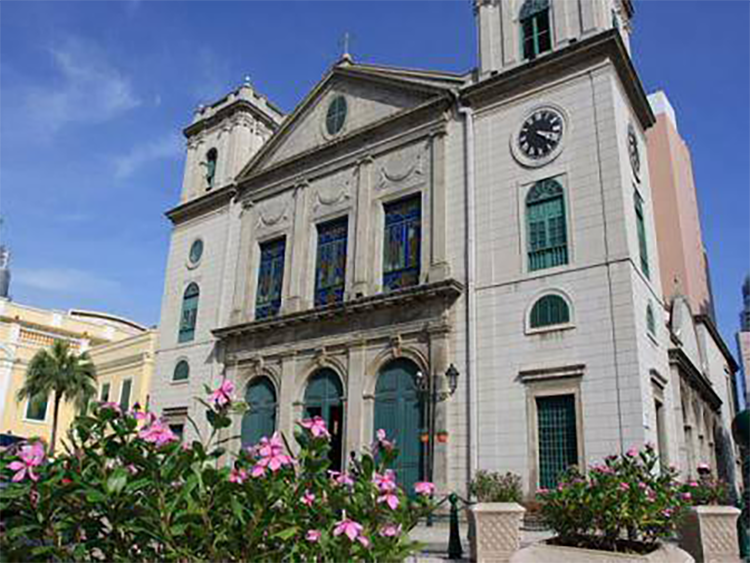Explore Macau Heritage: The Cathedral’s 400 Years of Faith and Culture
Introduction: A Beacon of Faith Across Time
Tucked among the busy streets of the Macau Peninsula, a soft-yellow, dignified building has stood for four centuries. This is the spiritual heart of Macau’s Catholic Diocese — the Cathedral (locally called the “大堂”/the Cathedral). When sunlight pours through stained glass onto the Baroque altar and the bell tolls mingle with street life, this UNESCO-listed church reveals Macau’s unique history as an “Eastern Vatican.”
1. Core Features: A Landmark Where Neoclassical Meets Baroque
“Macau’s oldest Catholic church, witnessing Sino‑Portuguese religious and artistic dialogue.”
As the diocese’s central church, the Cathedral holds an irreplaceable position:
– Architectural spirit: The present core was completed in 1850. Its Neoclassical exterior (clean columns, triangular pediment) contrasts dramatically with richly decorated Baroque interiors — a rare European-style sacred building in Macau.
– World Heritage: In 2005 it became part of the UNESCO-listed Historic Centre of Macau.
– Living faith: Traditional events such as the annual “Jesus of Sorrows” Lenten procession draw both worshippers and visitors, continuing a religious life that dates back to the 16th century.
2. Historical Development: From a Wooden Chapel to World Heritage
– 1576: Macau Diocese established; the first church was a simple wooden structure.
– 17th–19th centuries: Rebuilt several times after typhoons and fires, and took its present Neoclassical form in 1850.
– 1937: Major reconstruction; officially elevated to a cathedral (the bishop’s church).
– 2005: Included in the successful World Heritage nomination with 22 other historic sites in Macau.
Cultural role: The Cathedral is not only the spiritual center for Macau Catholics but also a focal point where colonial religious authority and civic life intersected during Portuguese rule.

3. Architecture and Art: Sacred Stories in the Details
Exterior: Neoclassical dignity
– Soft-yellow facade: The warm hue complements the Southern European atmosphere of the old city.
– Iconic bell towers: Symmetrical towers once served as a time signal for ships during the Age of Sail.
– Triangular pediment: A Latin inscription crowns the pediment, symbolizing heavenly authority.
Interior: A Baroque poem of light and shadow
– Latin cross plan: The typical Catholic layout with a nave and transepts forming a cross-shaped space.
– Main altar: Houses a statue of the Virgin Mary; gilded carvings and marble columns showcase Baroque grandeur.
– Stained glass windows: Biblical scenes are depicted in colored panes; sunlight casts vivid patterns on the floor.
– Side chapels: Devotional altars for Jesus and various saints, where the work of Chinese craftsmen shows a localized interpretation of European styles.
4. Religious Activities and Immersive Experiences
Daily life for worshippers and visitors
– Mass and prayer: Daily services (in Portuguese and Cantonese); visitors may observe quietly.
– Jesus of Sorrows procession (Lent): Macau’s largest religious parade, with the statue processed from the Cathedral through the old streets.
– Quiet moments: Candle‑lighting areas in the side chapels are open to non‑believers seeking silence.
Etiquette tips:
– Dress modestly: avoid shorts or sleeveless tops; set phones to silent.
– Photography: no flash photography inside; avoid moving around during Mass.

5. Atmosphere and Visitor Flow
– Who you’ll meet: Local parishioners, history lovers, and wedding photographers — roughly equal shares.
– Best times: Early morning (8–10 AM) when angled sunlight lights up the stained glass, or at dusk when the bells ring.
– Surroundings: The church square often hosts street performers and connects to Senado Square’s Portuguese pavement.
6. Suggested Itineraries
– Recommended visit length: 1 hour (longer if you want to study the art closely).
– Combined walks:
– Cultural route: Cathedral → St. Dominic’s Church → Ruins of St. Paul’s → Macau Museum (all within a 10-minute walk).
– Pilgrimage route: Cathedral → St. Joseph’s Seminary → St. Lawrence’s Church (the three historic churches of Macau).
7. Practical Tips
– Opening hours: 7:30–18:30 (Mass times may vary).
– Admission: Free; voluntary donations welcome.
– Getting there:
– Bus: Routes 3, 4, 6A, 8A to “Senado Square” stop, then 3 minutes on foot.
– Walk: About 8 minutes downhill from the Ruins of St. Paul’s.
– Languages: Portuguese and Cantonese are common; English signage is available.
– Facilities: No public restroom inside (Senado Square nearby has facilities).
Conclusion: An Essential Spiritual Landmark in Macau
The Cathedral is not a cold relic but a living museum of faith, art, and colonial history. Whether you are a believer or not, its stained glass, bell tones, and whispered prayers reveal Macau beyond the casinos — a gentle, steadfast city shaped by East–West encounters.


